Sustainable Development Goal 15
Sustainably manage forests, combat desertification, halt and reverse land degradation, halt biodiversity loss
Sustainable Development Goal 15 is to “conserve life on land”, according to the United Nations.
The visualizations and data below present the global perspective on where the world stands today and how it has changed over time.
The UN has defined 12 targets and 14 indicators for SDG 15. Targets specify the goals and indicators represent the metrics by which the world aims to track whether these targets are achieved. Below we quote the original text of all targets and show the data on the agreed indicators.
List of targets and indicators
Target 15.1Conserve and restore terrestrial and freshwater ecosystems
SDG Indicator 15.1.1Forest cover
Definition of the SDG indicator: Indicator 15.1.1 is “forest area as a proportion of total land area” in the UN SDG framework.
Forest area is land under natural or planted stands of trees of at least 5 meters in situ, whether productive or not, and excludes tree stands in agricultural production systems (for example, in fruit plantations and agroforestry systems) and trees in urban parks and gardens.
Target: “By 2020, ensure the conservation, restoration and sustainable use of terrestrial and inland freshwater ecosystems and their services.”1
Unlike most SDGs which have a target year of 2030, this indicator was set to be achieved by 2020.
More research: Further data and research can be found on the Our World in Data page on forest area.
Additional charts
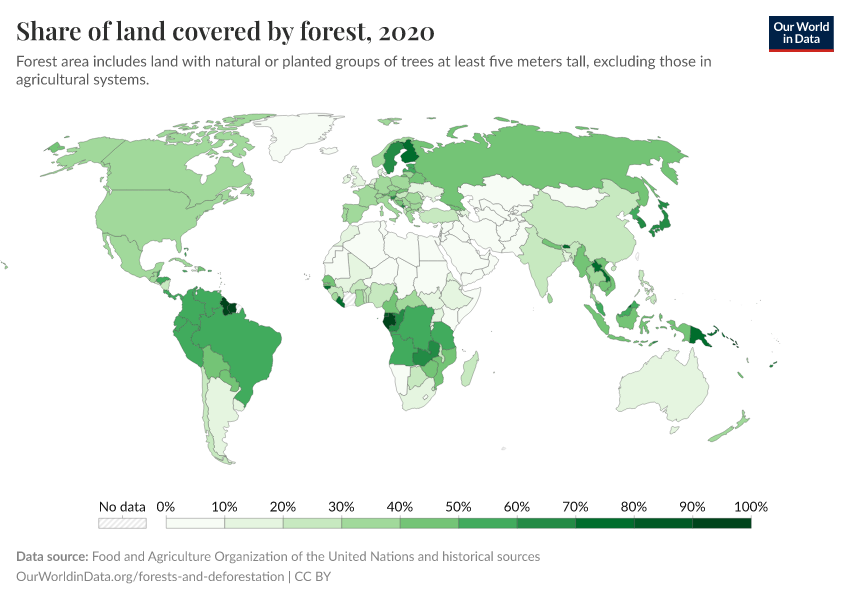
SDG Indicator 15.1.2Protection of important biodiversity areas
Definition of the SDG indicator: Indicator 15.1.2 is the “proportion of important sites for terrestrial and freshwater biodiversity that are covered by protected areas, by ecosystem type” in the UN SDG framework.
Protected areas are covered by three indicators: the proportion of total terrestrial area classified as protected; proportion of key terrestrial biodiversity areas that are protected; and proportion key freshwater biodiversity areas that are protected.
Target: “By 2020, ensure the conservation, restoration and sustainable use of terrestrial and inland freshwater ecosystems and their services.”1
Unlike most SDGs which have a target year of 2030, this indicator was set to be achieved by 2020.
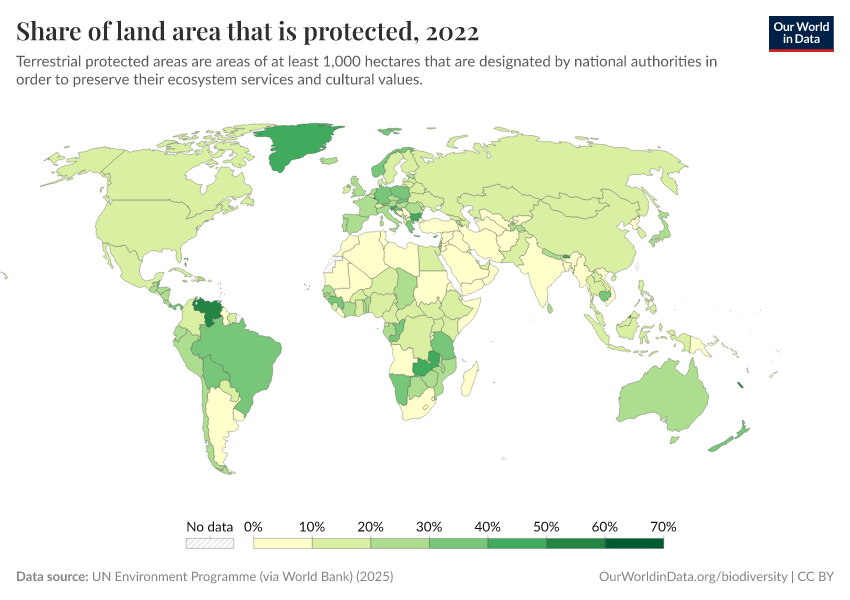
Target 15.2End deforestation and restore degraded forests
SDG Indicator 15.2.1Sustainable forest management
Definition of the SDG indicator: Indicator 15.2.1 is “progress towards sustainable forest management” in the UN SDG framework.
Sustainable Forest Management (SFM) is composed of five sub-indicators that measure progress towards all dimensions of sustainable forest management.
Three sub-indicators focus on the expansion of forest area, above-ground biomass within the forest area and the protection of forest biodiversity. The fourth relates to the availability of a long-term forest management plan; and the final indicator measures areas which are independently verified for compliance with a set of national or international standards.
Target: “By 2020 promote the implementation of sustainable management of all types of forests, halt deforestation, restore degraded forests and substantially increase afforestation and reforestation globally.”
Unlike most SDGs which have a target year of 2030, this indicator was set to be achieved by 2020.
More research: Further data and research can be found on the Our World in Data page on deforestation and forest loss.
Additional charts
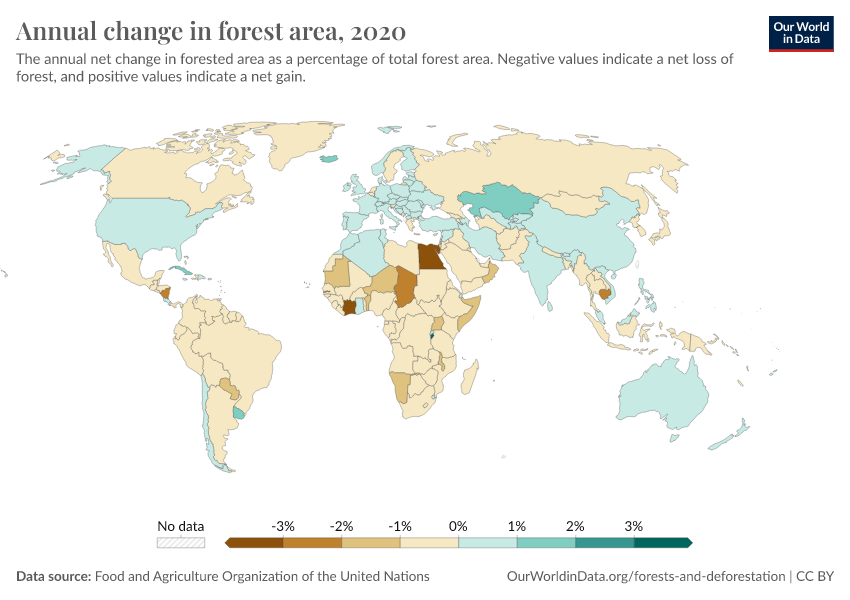
Target 15.3End desertification and restore degraded land
SDG Indicator 15.3.1End land degradation
Definition of the SDG indicator: Indicator 15.3.1 is the “proportion of land that is degraded over total land area” in the UN SDG framework.
This indicator is assessed using three sub-indicators:
i) Trends in land cover: An example of land degradation due to land cover change is the conversion of forests into croplands or settlements.
ii) Trends in land productivity: Land productivity is measured in terms of Net Primary Productivity (NPP) of vegetation. Land is considered degraded in terms of productivity if its NPP is less than half the value of the 90th percentile NPP in the same region.
iii) Carbon stock: This is considered degraded if there is a net reduction of 10% or more in soil organic carbon between the baseline and current observations.
If any of the sub-indicators is deemed degraded for a specific land unit, it will be classified as degraded, pending validation by national authorities.
Target: “By 2030, combat desertification, restore degraded land and soil, including land affected by desertification, drought and floods, and strive to achieve a land degradation-neutral world.”

Target 15.4Ensure conservation of mountain ecosystems
SDG Indicator 15.4.1Coverage of important sites for mountain biodiversity
Definition of the SDG indicator: Indicator 15.4.1 is “coverage by protected areas of important sites for mountain biodiversity” in the UN SDG framework.
This indicator measures the average share of each important site for mountain biodiversity that is covered by designated protected areas. The indicator does not measure the effectiveness of protected areas in reducing biodiversity loss, which depends on a range of management and enforcement factors.
Target: “By 2030, ensure the conservation of mountain ecosystems, including their biodiversity, in order to enhance their capacity to provide benefits that are essential for sustainable development.”
More research: Further data and research can be found at the Our World in Data topic page on biodiversity.
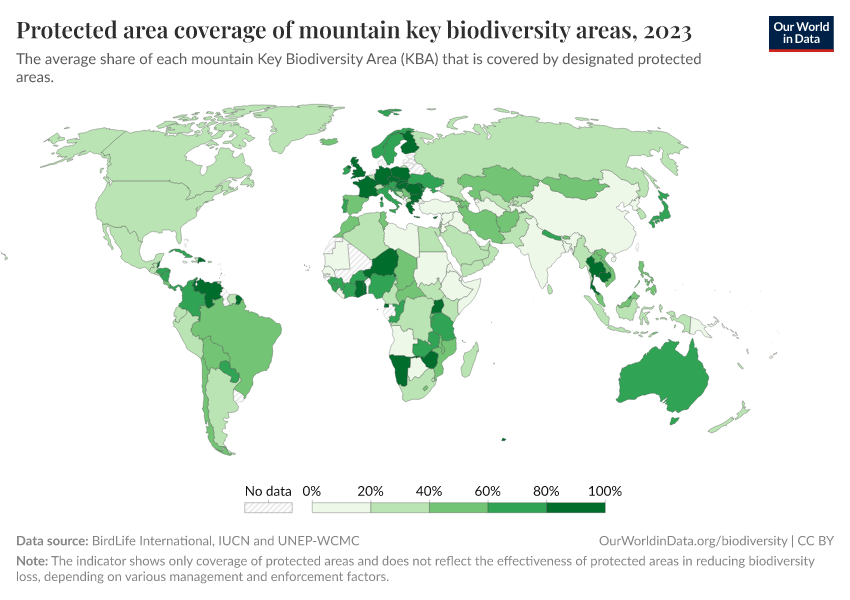
SDG Indicator 15.4.2Vegetation coverage of mountainous areas
Definition of the SDG indicator: Indicator 15.4.2 is the “(a) Mountain Green Cover Index and (b) proportion of degraded mountain land” in the UN SDG framework.
The Mountain Green Cover Index measures the percentage of mountainous areas covered by some form of green vegetation.
The Index measures the changes of the green vegetation in mountain areas - i.e. forest, shrubs, trees, pasture land, crop land, etc. – in order to monitor progress on the mountain target. This is monitored through high resolution satellite imagery.
Target: “By 2030, ensure the conservation of mountain ecosystems, including their biodiversity, in order to enhance their capacity to provide benefits that are essential for sustainable development.”
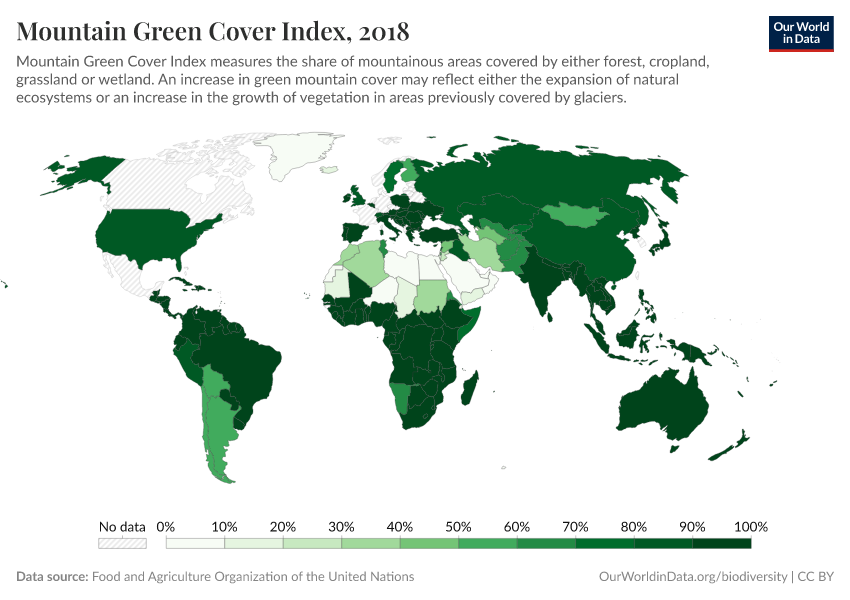
Target 15.5Protect biodiversity and natural habitats
SDG Indicator 15.5.1Species extinction risk
Definition of the SDG indicator: Indicator 15.5.1 is the “Red List Index” in the UN SDG framework.
The Red List Index (RLI) shows the trends in overall extinction risk for groups of species. An RLI value of 1.0 equates to all species in the group being categorised as 'Least Concern', and hence that none are expected to go extinct in the near future. A value of 0 indicates that all species have gone extinct.
Target: “Take urgent and significant action to reduce the degradation of natural habitats, halt the loss of biodiversity and, by 2020, protect and prevent the extinction of threatened species.”
More research: Further data and research can be found at the Our World in Data topic page on biodiversity.
Additional charts

Target 15.6Protect access to genetic resources and fair sharing of the benefits
SDG Indicator 15.6.1Benefits of sharing genetic resources
Definition of the SDG indicator: Indicator 15.6.1 is the “number of countries that have adopted legislative, administrative and policy frameworks to ensure fair and equitable sharing of benefits” in the UN SDG framework.
This indicator is measured through several sub-indicators that track countries’ participation in protocols concerned with the promotion and sharing of genetic resources for plants, food and agriculture, such as the Nagoya Protocol and the International Treaty on Plant Genetic Resources.
Target: “By 2030 promote fair and equitable sharing of the benefits arising from the utilization of genetic resources and promote appropriate access to such resources, as internationally agreed.”
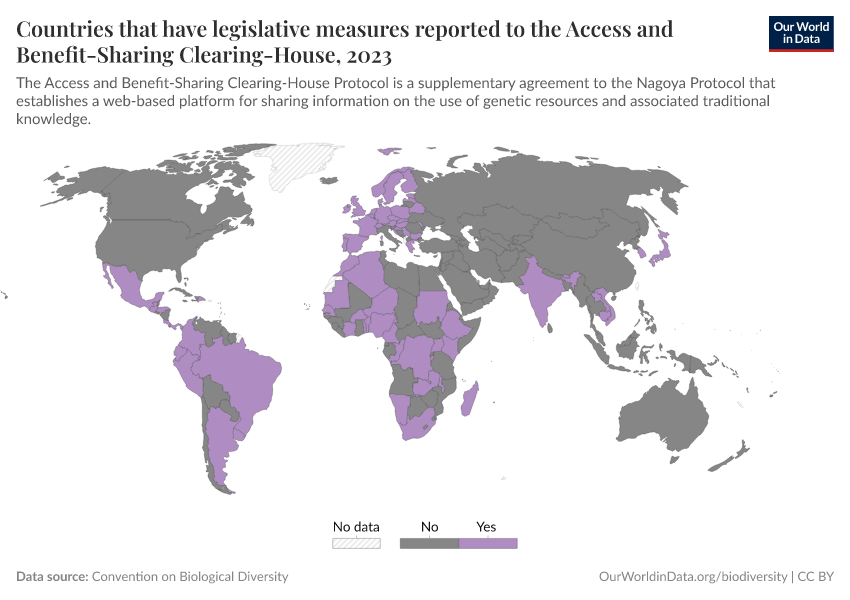
Target 15.7Eliminate poaching and trafficking of protected species
SDG Indicator 15.7.1Wildlife poaching and trafficking
Definition of the SDG indicator: Indicator 15.7.1 is the “proportion of traded wildlife that was poached or illicitly trafficked” in the UN SDG framework.
Internationally comparable data on this indicator is not currently available, and is thus not reported here.
Target: “Take urgent action to end poaching and trafficking of protected species of flora and fauna and address both demand and supply of illegal wildlife products.”
Additional charts
No data for this indicator
We are currently not aware of data for this indicator. You can notify us of available data for this indicator via our feedback form.
Target 15.8Prevent invasive alien species on land and in water ecosystems
SDG Indicator 15.8.1Prevent invasive alien species
Definition of the SDG indicator: Indicator 15.8.1 is the “proportion of countries adopting relevant national legislation and adequately resourcing the prevention or control of invasive alien species” in the UN SDG framework.
Alien species are those which have been introduced outside their natural distribution range through either intentional or accidental dispersion by human activity.
Invasive alien species impact native biodiversity through competition for resources, predation, hybridisation, disease transmission, parasitism, herbivory and trampling and rooting. The outcomes of these impacts lead to biodiversity loss, habitat degradation, and loss of ecosystem services.
Data for this indicator is shown in the interactive visualization.
Target: “By 2020, introduce measures to prevent the introduction and significantly reduce the impact of invasive alien species on land and water ecosystems and control or eradicate the priority species.”
Unlike most SDG targets which are set to be achieved by 2030, this indicator was to be achieved by 2020.
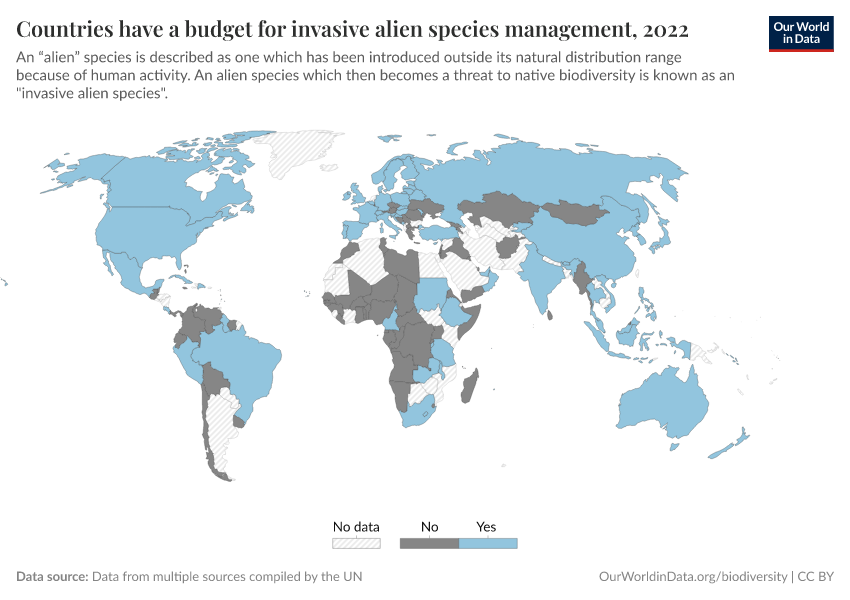
Target 15.9Integrate ecosystem and biodiversity in governmental planning
SDG Indicator 15.9.1Integration of ecosystem and biodiversity in planning
Definition of the SDG indicator: Indicator 15.9.1 is the “(a) number of countries that have established national targets in accordance with or similar to Aichi Biodiversity Target 2 of the Strategic Plan for Biodiversity 2011–2020 in their national biodiversity strategy and action plans and the progress reported towards these targets; and (b) integration of biodiversity into national accounting and reporting systems, defined as implementation of the System of Environmental-Economic Accounting” in the UN SDG framework.
Data for this indicator is shown in the interactive visualizations.
Target: “By 2020, integrate ecosystem and biodiversity values into national and local planning, development processes, poverty reduction strategies and accounts.”
Unlike most SDG targets which are set to be achieved by 2030, this indicator was to be achieved by 2020.

Target 15.aIncrease financial resources to conserve and sustainably use ecosystem and biodiversity
SDG Indicator 15.a.1Official development assistance for biodiversity
Definition of the SDG indicator: Indicator 15.a.1 is the “(a) Official development assistance on conservation and sustainable use of biodiversity; and (b) revenue generated and finance mobilized from biodiversity-relevant economic instruments” in the UN SDG framework.
This indicator is reported as the annual official development assistance (ODA) for biodiversity by recipient, and value of assistance by donor.
Official development assistance refers to flows to countries and territories on the OECD’s Development Assistance Committee (DAC) and to multilateral institutions which meet a set of criteria related to the source of the funding, the purpose of the transaction, and the concessional nature of the funding.
Although they are different indicators the data to track both 15.a.1 and 15.b.1 is currently the same.
Target: “Mobilize and significantly increase financial resources from all sources to conserve and sustainably use biodiversity and ecosystems.”
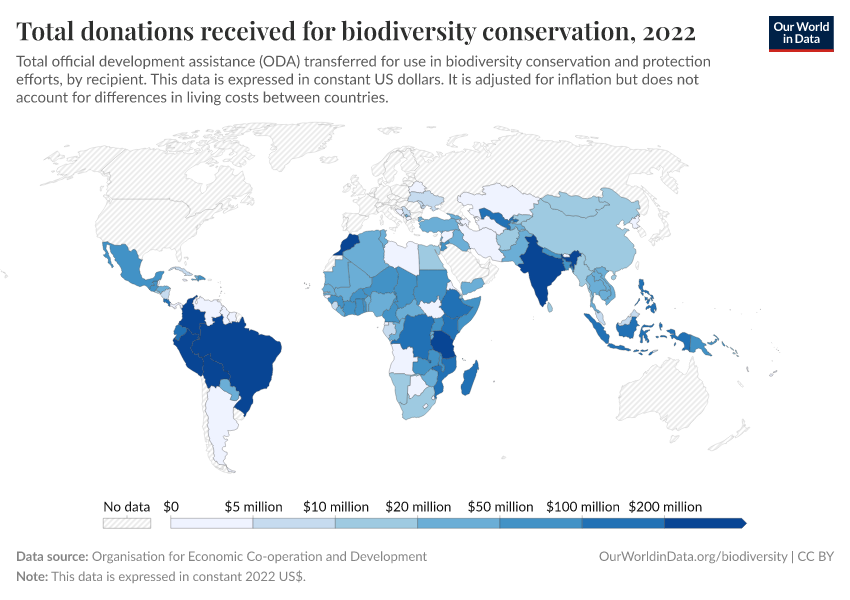
Target 15.bFinance and incentivize sustainable forest management
SDG Indicator 15.b.1Official development assistance for forest management
Definition of the SDG indicator: Indicator 15.b.1 is the “(a) official development assistance on conservation and sustainable use of biodiversity; and (b) revenue generated and finance mobilized from biodiversity-relevant economic instruments” in the UN SDG framework.
This indicator is reported as the annual official development assistance (ODA) for biodiversity by recipient, and value of assistance by donor.
Official development assistance refers to flows to countries and territories on the OECD’s Development Assistance Committee (DAC) and to multilateral institutions which meet a set of criteria related to the source of the funding, the purpose of the transaction, and the concessional nature of the funding.
Although they are different indicators the data to track both 15.a.1 and 15.b.1 is currently the same.
Target: “Mobilize significant resources from all sources and at all levels to finance sustainable forest management and provide adequate incentives to developing countries to advance such management, including for conservation and reforestation.”

Target 15.cCombat global poaching and trafficking
SDG Indicator 15.c.1Poaching and trafficking wildlife
Definition of the SDG indicator: Indicator 15.c.1 is the “proportion of traded wildlife that was poached or illicitly trafficked”, in the UN SDG framework.
Internationally comparable data on this indicator is not currently available, and is thus not reported here.
Target: “Enhance global support for efforts to combat poaching and trafficking of protected species, including by increasing the capacity of local communities to pursue sustainable livelihood opportunities.”
No data for this indicator
We are currently not aware of data for this indicator. You can notify us of available data for this indicator via our feedback form.
Endnotes
Full text: “By 2020, ensure the conservation, restoration and sustainable use of terrestrial and inland freshwater ecosystems and their services, in particular forests, wetlands, mountains and drylands, in line with obligations under international agreements.”
Cite this work
Our articles and data visualizations rely on work from many different people and organizations. When citing this article, please also cite the underlying data sources. This article can be cited as:
Our World in Data team (2023) - “Sustainably manage forests, combat desertification, halt and reverse land degradation, halt biodiversity loss” Published online at OurWorldinData.org. Retrieved from: 'https://archive.ourworldindata.org/20260105-112424/sdgs/life-on-land.html' [Online Resource] (archived on January 5, 2026).BibTeX citation
@article{owid-sdgs-life-on-land,
author = {Our World in Data team},
title = {Sustainably manage forests, combat desertification, halt and reverse land degradation, halt biodiversity loss},
journal = {Our World in Data},
year = {2023},
note = {https://archive.ourworldindata.org/20260105-112424/sdgs/life-on-land.html}
}Reuse this work freely
All visualizations, data, and code produced by Our World in Data are completely open access under the Creative Commons BY license. You have the permission to use, distribute, and reproduce these in any medium, provided the source and authors are credited.
The data produced by third parties and made available by Our World in Data is subject to the license terms from the original third-party authors. We will always indicate the original source of the data in our documentation, so you should always check the license of any such third-party data before use and redistribution.
All of our charts can be embedded in any site.